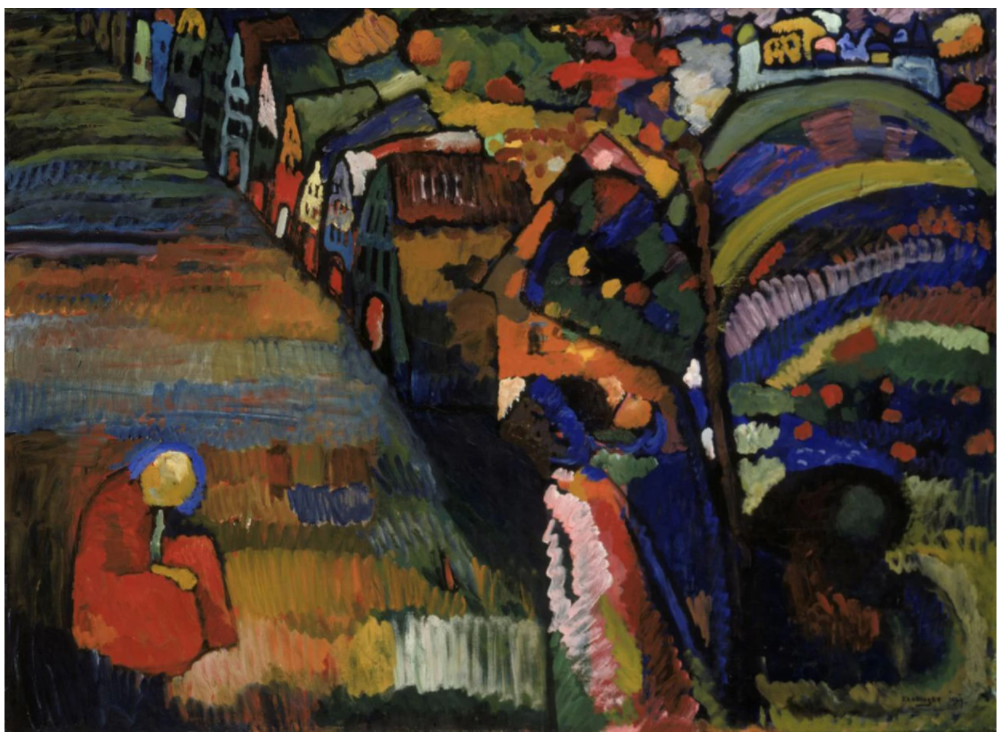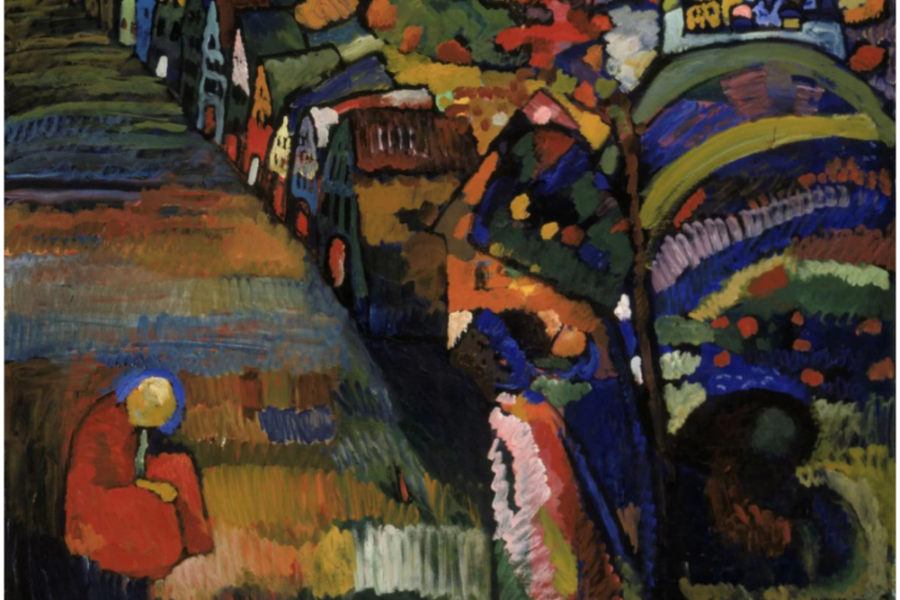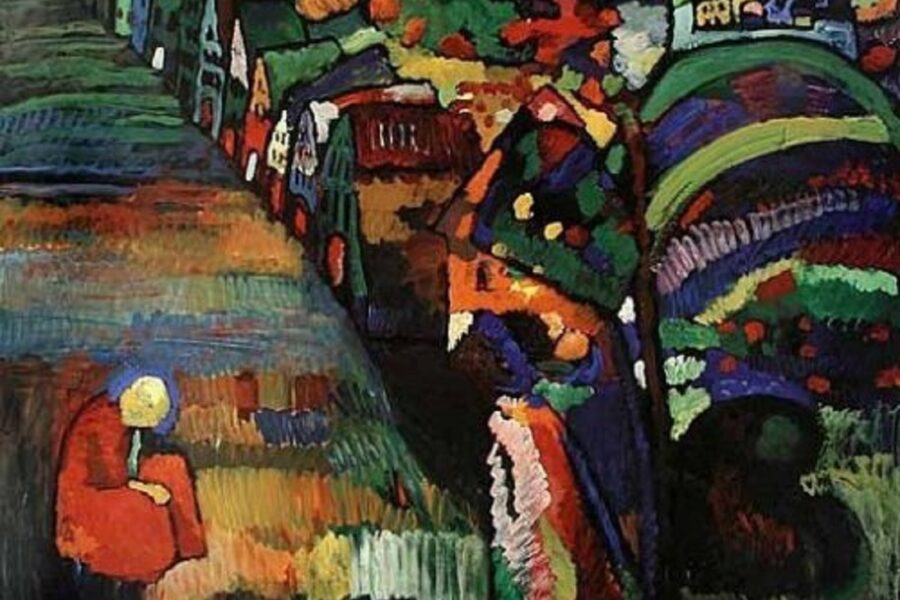[THIS IS AN ENGLISH TRANSLATION OF THE ORIGINAL DUTCH ARTICLE “Gemeente Amsterdam wil Kandinsky uit het Stedelijk wellicht toch teruggeven aan erven” PUBLISHED ON NRC.NL ON FEBRUARY 22, 2021].(https://www.nrc.nl/nieuws/2021/02/22/bild-mit-hausern-van-wassily-kandinsky-wellicht-toch-terug-naar-de-erven-a4032716)
Restitution of Nazi looted art The Municipality of Amsterdam is leading the way in adopting the recommendations of the Kohnstamm Commission, which ruled that restitution of Nazi looted art to Jewish heirs is done with little empathy. This could have consequences for the Stedelijk Museum.
Toef Jaeger February 22, 2021 Reading time 2 minutes

Wassily Kandinsky, ‘Bild mit Häusern’ (1909).
Photo collection Stedelijk Museum Amsterdam
Although in mid-December the Amsterdam court ruled that the municipality of Amsterdam did not have to return the painting Bild mit Häusern (1909) by Wassily Kandinsky to the Lewenstein heirs, the municipality believes that there are question marks over that decision. There is therefore a chance that the Stedelijk Museum still will have to hand over the painting – of which the heirs applied for restitution in 2012. Mayor Femke Halsema and culture alderman Touria Meliani (GroenLinks) write in a letter to the city council that they are following the advice of the Kohnstamm committee. They want the request of Lewenstein’s heirs to be reconsidered.
In the report Striving for Justice, the Kohnstamm Committee advised outgoing Minister Van Engelshoven (D66) at the end of 2020 that the Dutch policy on restitution of works of art stolen by the Nazis was too formalistic, and that, moreover, poor and insufficiently empathetic communication was being made with the applicants.
“The suffering inflicted on Jewish citizens in particular during World War II is unprecedented and irreversible,” Halsema and Meliani write in the council letter, which was sent Friday. “The Jewish citizens were taken away property, rights, dignity and in many cases life. To the extent that anything can still be recovered from the great injustice done to them, we as a society have a moral obligation to act accordingly. This certainly applies to the many works of art that were owned by Jewish citizens and were looted by Nazis or otherwise lost to their owners.”
With today’s knowledge
The municipality has owned the painting since 1940. Before that, it belonged to the art collection of the Lewenstein couple. With the Kohnstamm report in mind, the municipality believes it is likely that the decision of the Restitutions Committee, which stated in 2018 that the painting should not be returned, would now turn out differently.
The letter explicitly mentions Bild mit Häusern – which was bought at an Amsterdam auction in October 1940 by David Roëll, the then director of the Stedelijk Museum. “This means that the Commission advocates a re-evaluation by the Restitutions Committee of the application for restitution of the work Bild mit Häusern by Wassily Kandinsky on the basis of an adjusted assessment framework.” The alderman also states “that the new assessment framework, as proposed by the Kohnstamm Committee, should apply not only to new restitution cases, but also to current and already settled cases, and will of course bear any consequences.”
Municipality is leading the way
The restitution policy of Nazi looted art in the Netherlands has long been criticized internationally. Of the 74 countries that signed the Washington Principles in 1998 – which set out agreements on how involuntarily lost works of art can be returned to descendants – the Netherlands is the only one where the importance of the collection in the museum is taken into account. Since 2005 there has also been a strict division between private owners and art dealers.
It is not yet known whether the advice will be adopted. The Municipality of Amsterdam is leading the way in this regard, and in any case wants “to continue to make active efforts in the future – together with residents, museums involved and also in an international context – to get works of art that were involuntarily removed from the possession during World War II due to circumstances directly related to the Nazi regime, to heirs of the owners at the time, where possible.”
RESPONSES TO THE COUNCIL LETTER:
Rein Wolfs, director of the Stedelijk Museum: “Empathy is becoming increasingly important. It is only logical that the owners will have to take a step back, that the art-historical value will be given less weight and that the interests of the claimants will be given more weight. I am curious to see what the minister is going to decide. It’s a big deal because this is about a Kandinsky and because a similar claim is at play with Kandinsky’s The Colourful Life (1907) in the Lenbachhaus in Munich. The Netherlands is internationally criticized for its restitution policy and closely watched. That the City of Amsterdam is now anticipating the ministerial decision is because it is important for the city that you show that you are guided by the injustice that has been done. If you give something back, that is an emotional recovery.”
Axel Hagedorn, a lawyer on behalf of the Lewenstein heirs: “We are pleased that the municipality acknowledges that the advice given in 2018 was incorrect, but there are major objections to a new procedure at the restitution commission. It took years to settle the previous claim. And you only propose a new procedure if you think there is something wrong with the previous decision-making, with the value that was attached to the weighing of interests. So then return the work to the heirs immediately. The heirs are happy that there is finally movement. The attitude of the municipality of Amsterdam and the Stedelijk Museum during the hearing at the court last December showed little empathy, and so the recognition is a positive sign. Abroad, no one understands anything about the decision of the Restitutions Committee in 2018, and the municipality of Amsterdam has a bad reputation as a result. Mayor Halsema realizes that. I am assuming that the Kohnstamm report will be adopted by this outgoing cabinet. The pressure to do so quickly will have increased because of this letter from the municipality of Amsterdam.”
Gert-Jan van den Bergh, an attorney with Bergh Stoop & Sanders involved in several restitution cases: “The letter from the municipality is not surprising in itself. The consequences of Kohnstamm’s report will be limited: in practice it is not that bad, three or four cases will be reviewed. The bulk of the rejections still has to do with the burden of proof and the Kohnstamm Committee says nothing about that, while the problem lies precisely with the burden of proof. The Kohnstamm report provides an important correction, but too much good faith is still allowed to play a role in the decision making process, leaving an opening for the weighing of interests. The Stedelijk Museum itself should have said much earlier: it is not right that we have this painting here and it must go back to the heirs. There is no doubt that Kandinsky’s work in 1940 was not a good faith purchase. Upon renewed advice, the Kandinsky will still go to the heirs.”



